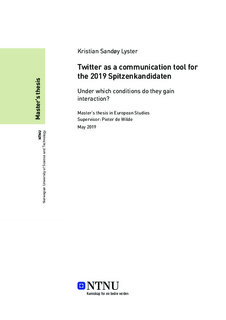| dc.description.abstract | This thesis is a study of how the 2019 Spitzenkandidaten were able to gain interaction on Twitter prior to the European elections taking place in May 2019. By both qualitatively and quantitatively assessing tweets, this thesis looks at how the candidates used Twitter, typical traits of the public discussing the elections, and compares how the candidates gained interaction on Twitter. The chosen time periods were 15th December 2018 to 15th March 2019 for the tweets posted by the candidates and 20th to 28th April 2019 for the tweets posted by the public. The thesis finds that all candidates all had different personalities and strategies on Twitter, even the ones representing the same political party. They were all different when it came to language patterns, how frequently they would use hashtags, and to what extent they would reply to other users. Furthermore, the results showed that the people tweeting about the elections mostly represented Western European member states and that they were generally quite neutral and objective in their tweet sentiments. Finally, this thesis found that some of the Spitzenkandidaten’s tweet topics such as Brexit and climate change were universally more likely to receive interactions than other topics. It also found that publishing tweets in English and frequently using hashtags were successful strategies for gaining interaction for most of the candidates. Despite these findings, the data was not sufficient to conclude whether other aspects of the candidates’ Twitter usage affected the number of interactions they gained. With this, it seems that there is not yet a golden route for successfully gaining interaction as a Spitzenkandidat on Twitter and that their interaction rates were likely influenced by external factors as well. | |
